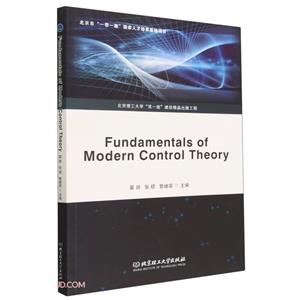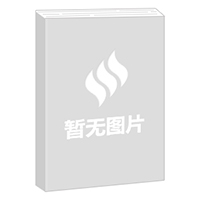掃一掃
關注中圖網
官方微博
>
Fundamentals of modern control theory
本類五星書更多>
-
>
貨幣大歷史:金融霸權與大國興衰六百年
-
>
(精)方力鈞作品圖錄
-
>
《藏書報》2021合訂本
-
>
(精)中國當代書畫名家作品集·范碩:書法卷+繪畫卷(全2卷)
-
>
(噴繪樓閣版)女主臨朝:武則天的權力之路
-
>
書里掉出來一只狼+狼的故事-全2冊
-
>
奇思妙想創意玩具書(精裝4冊)
Fundamentals of modern control theory 版權信息
- ISBN:9787576318050
- 條形碼:9787576318050 ; 978-7-5763-1805-0
- 裝幀:一般膠版紙
- 冊數:暫無
- 重量:暫無
- 所屬分類:
Fundamentals of modern control theory 內容簡介
《現代控制理論基礎》介紹現代控制理論的基本原理和控制系統分析與設計的主要方法,內容主要包括緒論、控制系統的狀態空間描述、線性控制系統的運動分析,線性控制系統的能控性和能觀測性,控制系統的李雅普諾夫穩定性分析,狀態反饋和狀態觀測器,*優控制。 本書可作為高等學校自動化、電氣工程及其自動化等專業的本科生全英文教材,也可作為機械工程、機電工程等非控制類專業的碩究生全英文教材,還可供控制領域的工程技術人員自學與參考。
Fundamentals of modern control theory 目錄
Chapter 1 Introduction
1.1 Introduction to Control Theory
1.2 The Development of Control Theory
1.3 The Knowledge System and Superiority of Modern Control Theory
1.4 Application of Modern Control Theory
Chapter 2 State Space Model
2.1 State Variable and State Space Expression
2.2 State Space Representation of Linear Dynamic System
2.3 System Block Diagram of State Space Expressions
2.4 Linear Transformation of State Equation
2.5 State Space Representation of Discrete System
Chapter 3 The Solution of State Space Expression
3.1 Solving the Time-invariant Homogeneous State Equation
3.2 Properties of State-Transition Matrices
3.3 The Calculation of Matrix Exponential Function
3.4 Solution of Nonhomogeneous State Equations
3.5 Solution of Discrete Nonhomogeneous State Equations
Chapter 4 Controllability and Observability of Linear Control Systems
4.1 Definition of Controllability
4.2 Controllability of Linear Time Invariant Systems
4.3 Observability of Linear Continuous Time Invariant Systems
4.4 Controllability and Observability of Discrete Time Systems
4.5 Controllability and Observability of Time-Varying System
4.6 Duality Relationship Between Observability and Controllability
4.7 Controllable Canonical Form Type and Observable Canonical Form Type of State Space Expression
4.8 Structural Decomposition of Linear Systems
4.9 Realization of Transfer Function Matrix
Chapter 5 Stability and Lyapunov Method
5.1 Definition of Stability for Lyapunov's Theory
5.2 Lyapunov's First Method
5.3 Lyapunov's Second Method
5.4 The Application of Lyapunov Method in Linear System
5.5 Application of Lyapunov Method in Nonlinear System
Chapter 6 Synthesis of Linear Time Invariant System
6.1 Basic Structure and Characteristics of Linear Feedback Control System
6.2 Pole Placement Issues
6.3 System Stabilization
6.4 System Decoupling Problem
6.5 State Observer
6.6 Using State Observer to Realize State Feedback System
Chapter 7 The Optimal Control
7.1 Introduction
7.2 Minimum Principle
7.3 Bang-Bang Control
7.4 Dynamic Programming Method
7.5 Linear Quadratic Optimal Control Problem
參考文獻
1.1 Introduction to Control Theory
1.2 The Development of Control Theory
1.3 The Knowledge System and Superiority of Modern Control Theory
1.4 Application of Modern Control Theory
Chapter 2 State Space Model
2.1 State Variable and State Space Expression
2.2 State Space Representation of Linear Dynamic System
2.3 System Block Diagram of State Space Expressions
2.4 Linear Transformation of State Equation
2.5 State Space Representation of Discrete System
Chapter 3 The Solution of State Space Expression
3.1 Solving the Time-invariant Homogeneous State Equation
3.2 Properties of State-Transition Matrices
3.3 The Calculation of Matrix Exponential Function
3.4 Solution of Nonhomogeneous State Equations
3.5 Solution of Discrete Nonhomogeneous State Equations
Chapter 4 Controllability and Observability of Linear Control Systems
4.1 Definition of Controllability
4.2 Controllability of Linear Time Invariant Systems
4.3 Observability of Linear Continuous Time Invariant Systems
4.4 Controllability and Observability of Discrete Time Systems
4.5 Controllability and Observability of Time-Varying System
4.6 Duality Relationship Between Observability and Controllability
4.7 Controllable Canonical Form Type and Observable Canonical Form Type of State Space Expression
4.8 Structural Decomposition of Linear Systems
4.9 Realization of Transfer Function Matrix
Chapter 5 Stability and Lyapunov Method
5.1 Definition of Stability for Lyapunov's Theory
5.2 Lyapunov's First Method
5.3 Lyapunov's Second Method
5.4 The Application of Lyapunov Method in Linear System
5.5 Application of Lyapunov Method in Nonlinear System
Chapter 6 Synthesis of Linear Time Invariant System
6.1 Basic Structure and Characteristics of Linear Feedback Control System
6.2 Pole Placement Issues
6.3 System Stabilization
6.4 System Decoupling Problem
6.5 State Observer
6.6 Using State Observer to Realize State Feedback System
Chapter 7 The Optimal Control
7.1 Introduction
7.2 Minimum Principle
7.3 Bang-Bang Control
7.4 Dynamic Programming Method
7.5 Linear Quadratic Optimal Control Problem
參考文獻
展開全部
書友推薦
- >
新文學天穹兩巨星--魯迅與胡適/紅燭學術叢書(紅燭學術叢書)
- >
自卑與超越
- >
中國人在烏蘇里邊疆區:歷史與人類學概述
- >
史學評論
- >
二體千字文
- >
月亮與六便士
- >
莉莉和章魚
- >
經典常談
本類暢銷


















